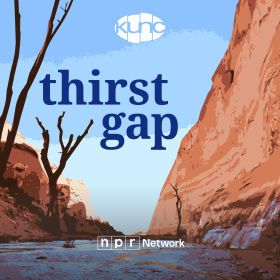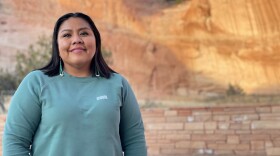
Thirst Gap is a six-part podcast series about how the Southwest is adapting to water shortages as climate change causes the region to warm up and dry out. The series zooms in on people and places grappling with limited water supplies in the Colorado River watershed, and examines the trade-offs that come with learning to live with less water.
The Colorado River is in trouble. Its biggest reservoirs are at record lows. Shortages are likely to get worse. Demands from cities and farms are outstripping supply across seven U.S. states, 30 Native American tribes and northern Mexico.

The river’s foundational, yet flawed, legal agreement -- the Colorado River Compact-- turned 100 years old in 2022. The anniversary was a somber one. Climate change is putting the compact’s most basic tenets to the ultimate test. The agreement’s fantastical promises, of an arid region flush with enough water to build massive cities and sprawling farms, have left the region’s key water source drained.
Climate change is warming parts of the basin faster than any other reach of the U.S. If the first 100 years of river management represent an attempt to ring every drop from the river for human use, the next 100 years will bring a heavy dose of reality -- that we’ve stretched the river too thin and need to rely on it less.
Who will be forced to give up the most? How do we decide who gets less? And how will the region adapt to a shrinking supply as the climate warms? This six-part in-depth audio series will attempt to answer those questions.


The Colorado River’s current crisis traces its roots back to 1922. That’s when leaders from the rapidly-growing southwestern states that rely on the river traveled to a swanky Santa Fe mountain retreat to divvy up the river’s water. Growing populations in some of the West’s burgeoning cities and sprawling farmlands, and the anxieties tied to that growth, pushed leaders to the negotiating table.
The Colorado River Compact was the result of those talks. This attempt to manage the dynamic river system was fraught from the very beginning. To get a deal passed the men overestimated the river’s flow, and ignored warnings from scientists they were setting the stage for a sprawling plumbing system bound to be short on water. Today we’re still grappling with the decisions made during those negotiations.
[We] needed to control nature. We needed to figure out a way to make this river from a menace to a natural resource, you know, to something that humans could use and rely on.Eric Kuhn
This episode features an interview with Eric Kuhn, former Colorado River District general manager, and co-author of Science Be Dammed: How Ignoring Inconvenient Science Drained The Colorado River.

Farmers and ranchers use the vast majority of the Colorado River’s water. Getting them to voluntarily use less is difficult. The West’s water rights system incentivizes farmers to use all of their water to prevent their rights from losing value. Trying to balance the region’s water supply and demand will require farmers to use less. In this episode we visit western Colorado’s Grand Valley, an irrigated green pocket in the desert famous for its peach orchards. The area was the testing ground for experimental conservation programs that would pay farmers to dry up some of their land in an effort to boost the river’s flagging reservoirs.
This episode features interviews with Troy Waters, a western Colorado farmer who relies on Colorado River water to irrigate his fields, and his son Calvin, who is preparing to take over the family farm. Plus, conversations with former Grand Valley Water Users Association general manager Mark Harris, and the association’s current general manager, Tina Bergonzini, about experimental conservation programs tested in the valley.
For more on the financial implications around the West's water issues, check out Cash Flows: How Investors Are Banking On The West’s Water Scarcity, a 2020 investigative series from KUNC, Aspen Journalism, The Nevada Independent and KJZZ.

Lake Powell is a boater’s dream. The nation’s second largest reservoir on the Colorado River is a maze of sandstone canyons teeming with houseboats. But climate change and unchecked demand for water sent the lake’s levels to a new record low this year. People who’ve hoped for years to see the reservoir drained are in awe of the change happening in front of their eyes.
In this episode we explore changes to recreation in this popular vacation hotspot. Wet winter weather this year will give it a boost, but long-term challenges remain.
We meet a couple who got married on a houseboat. We travel down the Colorado River into Lake Powell’s rapidly changing delta, where 100 foot piles of mud and sediment are being carved away by the returning river flows. We hike up Glen Canyon’s side canyons, once filled with water, which are now are havens for wildlife and vegetation.
This episode features conversations with Sheri Facinelli and Randy Redford, boaters who have spent decades vacationing at Lake Powell; Mike DeHoff and Pete Lefebvre, who co-lead the Returning Rapids Project; and Eric Balken, executive director of the Glen Canyon Institute.

Las Vegas is known as a city of excess. But not when it comes to water. The desert metropolis relies on the Colorado River to keep its iconic casinos bustling. The short supply has caused city leaders to enforce some of the tightest water conservation measures in the West. Green lawns are enemy number one.
This episode features interviews with Kurtis Hyde with Par 3 Landscape & Maintenance, a landscape company in the Las Vegas metro area, and John Entsminger, general manager of the Southern Nevada Water Authority. Also, conversations with Devyn Choltko with the Las Vegas Valley Water District and homeowners Linda and Raymond Marston.

This episode features interviews with Leila Help-Tulley, and her daughter, Crystal Tulley-Cordova, principal hydrologist with the Navajo Nation. Also, a conversation with Roland Tso, a grazing official with the community of Many Farms. We also hear oral arguments from a March 2023 Supreme Court hearing on Arizona v. the Navajo Nation.

Tribes in the southwest hold significant rights to the Colorado River’s water. But they’ve been left out of nearly every major agreement to manage the river. Leaders across the region are debating how to use less water amid the region’s warming climate. Tribes say they never got the chance to use their water in the first place, and that everyone in the river basin should plan for a future where they do.

The Colorado River comes to an end at the U.S.-Mexico border. The entirety of its flow, already heavily tapped upstream in the U.S., is sent into an irrigation canal to grow crops in the Mexicali Valley, and to flow through faucets in Tijuana and Mexicali.
The river’s final hundred miles have been mostly-dry for decades. Bringing water back to the river channel is fraught and expensive. Environmental groups on both sides of the border are working together to let the Colorado flow again in its historic channel. For a brief moment in summer 2022, the river’s water once again spilled into the Pacific Ocean.
In this episode we hear from Tomás Rivas, a marine biologist with the Sonoran Institute, and Aída Navarro, coordinator for Raise the River -- Alianza Revive el Río Colorado. Also, conversations with Ricardo Escobedo of Restauremos El Colorado and Carlos de la Parra, a professor at El Colegio de la Frontera Norte in Tijuana.








































